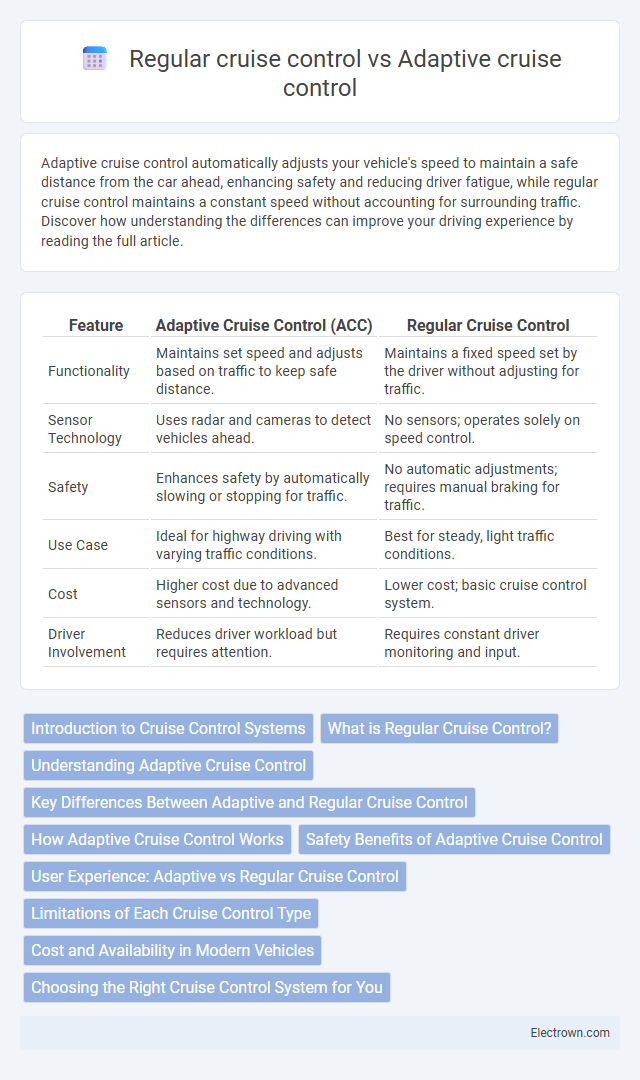Adaptive cruise control automatically adjusts your vehicle's speed to maintain a safe distance from the car ahead, enhancing safety and reducing driver fatigue, while regular cruise control maintains a constant speed without accounting for surrounding traffic. Discover how understanding the differences can improve your driving experience by reading the full article.
Table of Comparison
| Feature | Adaptive Cruise Control (ACC) | Regular Cruise Control |
|---|---|---|
| Functionality | Maintains set speed and adjusts based on traffic to keep safe distance. | Maintains a fixed speed set by the driver without adjusting for traffic. |
| Sensor Technology | Uses radar and cameras to detect vehicles ahead. | No sensors; operates solely on speed control. |
| Safety | Enhances safety by automatically slowing or stopping for traffic. | No automatic adjustments; requires manual braking for traffic. |
| Use Case | Ideal for highway driving with varying traffic conditions. | Best for steady, light traffic conditions. |
| Cost | Higher cost due to advanced sensors and technology. | Lower cost; basic cruise control system. |
| Driver Involvement | Reduces driver workload but requires attention. | Requires constant driver monitoring and input. |
Introduction to Cruise Control Systems
Adaptive cruise control uses radar and cameras to automatically adjust vehicle speed based on the distance to the car ahead, enhancing safety and convenience. Regular cruise control maintains a set speed without accounting for traffic conditions, requiring manual braking or acceleration to respond to changes. Advanced driver assistance technologies integrate adaptive systems to reduce driver workload and improve traffic flow.
What is Regular Cruise Control?
Regular cruise control is a driver-assistance system designed to maintain a constant vehicle speed without continuous accelerator input. It allows drivers to set a fixed speed, improving comfort during long highway drives by reducing fatigue. Unlike adaptive cruise control, it does not automatically adjust speed based on surrounding traffic conditions.
Understanding Adaptive Cruise Control
Adaptive Cruise Control (ACC) enhances traditional cruise control by automatically adjusting the vehicle's speed to maintain a safe distance from the car ahead, utilizing sensors such as radar and cameras. Unlike regular cruise control, which requires manual speed adjustments, ACC dynamically responds to traffic conditions, improving safety and reducing driver fatigue. This system significantly contributes to advanced driver-assistance by providing smoother acceleration and deceleration on highways.
Key Differences Between Adaptive and Regular Cruise Control
Adaptive cruise control uses radar and sensors to automatically adjust vehicle speed, maintaining a safe distance from the car ahead, while regular cruise control maintains a constant speed without accounting for traffic conditions. Adaptive cruise control enhances safety by responding to changing road conditions, reducing driver fatigue in stop-and-go traffic, whereas regular cruise control is best suited for steady highway speeds. The integration of adaptive systems offers advanced features like automatic braking and acceleration, which are absent in traditional cruise control.
How Adaptive Cruise Control Works
Adaptive Cruise Control (ACC) uses radar and camera sensors to maintain a set speed while automatically adjusting the vehicle's distance from the car ahead, enhancing safety and convenience. Unlike regular cruise control, which maintains a fixed speed regardless of traffic conditions, ACC continuously monitors surrounding traffic and slows down or accelerates accordingly. This technology reduces driver fatigue and helps prevent collisions by adapting to real-time road scenarios.
Safety Benefits of Adaptive Cruise Control
Adaptive cruise control enhances driving safety by automatically adjusting the vehicle's speed to maintain a safe following distance from the car ahead, reducing the risk of rear-end collisions. Unlike regular cruise control, which maintains a constant speed regardless of traffic conditions, adaptive systems use radar and sensors to respond to changing road situations. This technology decreases driver fatigue and improves reaction time, especially in congested traffic, contributing to overall accident prevention and safer highway travel.
User Experience: Adaptive vs Regular Cruise Control
Adaptive cruise control enhances your driving experience by automatically adjusting speed to maintain a safe distance from the vehicle ahead, reducing the need for constant speed adjustments and improving road safety. Regular cruise control maintains a fixed speed, requiring manual intervention to slow down or accelerate, which can be less convenient in varying traffic conditions. The adaptive system offers smoother and more responsive control, making long drives less stressful and more comfortable compared to traditional cruise control.
Limitations of Each Cruise Control Type
Adaptive cruise control (ACC) faces limitations such as reduced effectiveness in severe weather conditions and challenges in accurately detecting stationary objects or sudden lane changes. Regular cruise control lacks the ability to automatically adjust speed based on traffic flow, increasing the risk of collisions in stop-and-go traffic or varying speed zones. Both systems require driver vigilance and are less effective on winding roads or in complex urban environments.
Cost and Availability in Modern Vehicles
Adaptive cruise control typically costs significantly more than regular cruise control due to its advanced sensors and radar technology, often adding between $500 to $2000 to the price of a vehicle. Regular cruise control is a standard feature in most modern cars, making it widely available and cost-effective for everyday drivers. Your choice depends on budget and preference, with adaptive systems becoming more accessible in mid-range and luxury models.
Choosing the Right Cruise Control System for You
Adaptive cruise control (ACC) uses radar and sensors to maintain a set distance from the vehicle ahead, automatically adjusting speed for traffic conditions, while regular cruise control maintains a constant speed without accounting for surrounding vehicles. Choosing the right cruise control system depends on your driving habits, traffic environments, and budget, with ACC offering enhanced safety and convenience for frequent highway driving. Consider factors such as adaptive features, ease of use, and compatibility with your vehicle to make an informed decision.
Adaptive cruise control vs Regular cruise control Infographic

 electrown.com
electrown.com